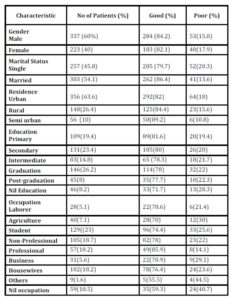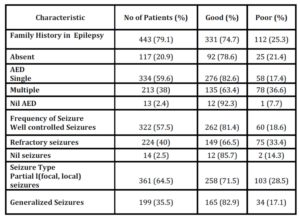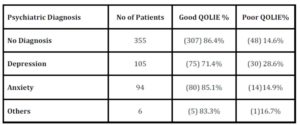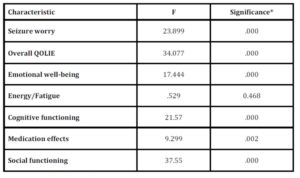Discussion
The purpose of our study was to identify factors influencing quality of life in epilepsy patients. According to the results, the study shows that factors associated with quality of life in adult epilepsy patients were psychiatric problems and AEDs. Absence of psychiatric problems and patients on single AED were associated with good quality of life and Psychiatric diagnosis (depression and anxiety) and multiple AEDs were strong predictors of poor quality of life. Previous work revealed that the most important determinants for patients with epilepsy were social and psychological aspects, effects of antiepileptic drugs and seizure frequency, which were determinants of poor QOL, scores (Suurmeijer, et al., 2001). This study shows no difference on the above mentioned factors on the score of QOL, though there was variation in seizure frequency. Another study by Yue L et al., (2011) indicated anxiety and seizure related variables as the strongest predictors of QOLIE among men.
In the present study depression and anxiety were prominent predictors for poor quality of life in epilepsy patients. Previous studies have also reported high prevalence of psychological and social disorders reported in-patients with epilepsy (Kogeorgos, et al., 1982). In a study by Lehrner et al., (1999) found depression was the single strongest predictor for each field of health —related quality of life in patients with temporal lobe epilepsy. There was a significant association with health related quality of life and depression which continued to exist even after controlling seizure frequency, seizure severity, and other psychosocial variables. Anxiety is a common consequence of the unpredictable nature of some epilepsies. (Guekht et al., 2007). People with epilepsy have been reported to be more prone to depression than those without epilepsy (Robertson et al., 1987). These studies support our finding that depression and anxiety were major determining factors for poor quality of life.
Herodes et al., (2001) indicated demographic variables such as age, sex and education as well as socio- economic status (SES) in determining the quality of life which was not significant. Leidy et al., (1993) reported that QOL differs across epilepsy patients with different clinical, demographic and socio economic variables. This is similar to our study single AED therapy showed good quality of life. With regard to clinical variables, multiple AED use was found to be a significant predictor of the quality of life poor scores, similar to the study by Suurmeijer et al., (2001). Seizure type was not a significant factor in the present study similar to other studies (Baker et al., 1997-98). The findings of our study are comparable to some studies where age, sex and education did not correlate significantly with the quality of life (Suurmeijer et al., 2001 & Baker et al., 2001).
Previous studies have highlighted the employment difficulties faced by persons with epilepsy i.e. underemployment and unemployment has been identified as two of the most serious problems, they face also lower rates of marriages (Floyd, 1986 & Rodin et al., 1972). The study by Djibuti and Shakarishvili (2003) revealed education as one of the strongest predictor of low quality of life. Unlike these studies according to our study most of the patients were either studying or employed in some profession though most of females happen to be housewives.
In conclusion, these findings show that psychiatric problems may be a potential challenge for people with epilepsy to cause poor QOL. Improving the patient’s quality of life (QOL) is one of the most important goals of epilepsy management and it may be necessary to individualize interventions such as counseling and psychotherapy techniques to improve the QOL in epilepsy patients. The major advantage of the study is large number of epilepsy patients but limitation is a cross- sectional study without control or follow-up. Our data also suggest multiple AED as powerful predictor of poor quality of life. The factor associated with QOL emphasizes the importance of effective treatment and alleviating anxiety and depression levels, which may improve the quality of life.
Abbreviations: International Classification of Disorders- (ICD-10), Liverpool seizure severity scale (LSSS) and Quality of life in epilepsy (QOLIE-31 & 89), Antiepileptic drugs (AED) & Analysis of variance (ANOVA’s).
References
1. Baker, G.A, Smith, D.F., Dewey, M., Morrow, J., Crawford, P.M., & Chadwick, D.W. (1991). The development of a seizure severity scale as an outcome measure in epilepsy. Epilepsy Res, 8(3): s 245—251.
Google Scholar
2. Baker, G.A., Gagnon, D., & McNotty, P. (1998). The relationship between seizure frequency, seizure type and quality of life: findings from three European countries. Epilepsy Res, 30:231-40.
Publisher – Google Scholar
3. Baker, G.A., Jacoby, A., Buck, D., Brooks, J., Potts, P., & Chadwick, D.W. (2001). The quality of life of older people with epilepsy: findings from a UK community study. Seizure, 10:92-9.
Publisher – Google Scholar
4. Baker, G.A., Jacoby, A., Buck, D., Stalgis, C., & Monnet, D. (1997). Quality of life of people with epilepsy: a European study. Epilepsia; 38:353-62.
Publisher – Google Scholar
5. Canuet, L., Ishii, R., Iwase M, Ikezawa K, Kurimoto R, Azechi M, Takahashi H, Nakahachi T, Teshima Y, Takeda M. (2009). Factors associated with impaired quality of life in younger and older adults with epilepsy. Epilepsy Res, 83 (1): 58-65.
Publisher – Google Scholar
6. Collings, J.A. (1990). Epilepsy and well-being. Soc Sci Med, 31:165-70.
Publisher – Google Scholar
7. Collings, S.J. (1990). Psycho social well-being and epilepsy: an empirical study. Epilepsia, 31:418-26.
Publisher – Google Scholar
8. Cramer, J.A (1994) .Quality of life for people with epilepsy. Neurol Clin, 12:1-13.
Google Scholar
9. Cramer, J.A., Perrine, K., Devinsky, O., Bryant-Comstock, L., Meador, K., & Hermann, B.P. (1998). Development and Cross-Cultural Translations of a 31-Item Quality of Life in Epilepsy Inventory. Epilepsia, 39(1): 81—88.
Google Scholar
10. Djibuti, M & Shakarishvili, R. (2003). Influence of clinical, demographic, and socio economic variables on quality of life in-patients with epilepsy: findings from Geargian study. J Neurol Neurosurg Psychiatry, 74:570-573.
Publisher – Google Scholar
11. Floyd, M. (1986). A review of published studies in epilepsy and employment. In: Edwards F, Espir M, Oxley J, Eds. Epilepsy and employment — a medical symposium on current problems and best practices. London: Royal Society of Medicine Services 1986.
12. Guekht, A.B., Mitrokhina, T.V., Lebedeva, A.V., Dzugaeva, F.K., Milchakova, L.E., Lokshina, O.B., Feygina, A.A., & Gusev, E.I. (2007). Factors influencing on quality of life in people with epilepsy. Seizure. Mar; 16(2):128-33.
Google Scholar
13. Hermann, B.P. (1993). Developing a model of quality of life in epilepsy: the contribution of neuropsychology. Epilepsia, 34(suppl 4): S14-21.
Publisher – Google Scholar
14. Herodes, M., Oun, A., Haldre, S., & Kaasik, A.E. (2001). Epilepsy in Estonia: a quality of life study. Epilepsia, 42:1061-73.
Publisher – Google Scholar
15. Jacoby, A. (1992). Epilepsy and the quality of everyday life. Findings from a study of people with well-controlled epilepsy. Soc Sci Med, 43:657-66.
Publisher – Google Scholar
16. Kogeorgos, J., Fonagy, P., & Scoff, D.F. (1982). Psychiatric symptoms patterns of chronic epileptics attending a neurological clinic: a controlled investigation. Br J. Psychiatry, 140:236-43.
Publisher – Google Scholar
17. Lehrner, J., Kalchmayr, R., Serles, W., Olbrich, A., Pataraia, E., Aull, S., Bacher, J., Leutmezer, F., Gröppel, G., Deecke, L., & Baumgartner, C. (1999). Health-related quality of life (HRQOL), activity of daily living (ADL) and depressive mood disorder in temporal lobe epilepsy patients. Seizure, 8(2):88-92.
Publisher – Google Scholar
18. Leidy, N.K., Elixhauser, A., Vickrey, B., Means, E., & Willian, M.K. (1993) Seizure frequency and the health-related quality of life of adults with epilepsy. Neurology, 53; 162-6.
19. Loring, D.W., Meador, K.J., & Lee, G.P. (2004). Determinants of quality of life in epilepsy. Epilepsy Behav. 5 (6):976-80.
Publisher – Google Scholar
20. Mihara, T. (1994). Comprehensive assessment of outcome in 100 patients followed for over 2 years after resective surgery for temporal lobe epilepsy (in Japanese). Shinkei Kenkyu No Shinpo, 38(5); 771-80.
21. Robertson, M.M., Trimble, M.R., & Townsend, H.R.A. (1987). Phenomenology of depression in epilepsy. Epilepsia, 28:364-72.
Publisher – Google Scholar
22. Rodin, E., Rennick, P., Denerell, R., & Lin, Y. (1972). Vocational and educational problems of epileptic patients. Epilepseia, 13:149-60.
Publisher – Google Scholar
23. Sander, JWAS. (1993). Some aspects of prognosis in the epilepsies: a review. Epilepsia, 34: 1007-16.
Publisher – Google Scholar
24. Suurmeijer, T.P., Reuvekamp, M.F., & Alden Kamp, B.P. (2001). Social functioning psychological functioning and quality of life in epilepsy. Epilepsia, 42:1160-8.
Publisher – Google Scholar
25. Tlusta, E., Zarubova, J., Simko, J., Hojdikova, H., Salek, S., & Vlcek, J. (2009). Clinical and demographic characteristics predicting QOL in patients with epilepsy in the Czech Republic: how this can influence practice. Seizure. Mar; 18 (2):85-9.
Google Scholar
26. Vickrey, B.G, Hays, R.D., Rausch, R., Sutherling, W.W., Engel, J. Jr, & Brook, R.H. (1994). Quality of life of epilepsy surgery patients as compared with -out patients with hypertension, diabetes, heart disease and/or depressive symptoms. Epilepsia, 35(3): 597-607.
Publisher – Google Scholar
27. Vickrey, B.G. (1993). A procedure for developing a quality of life measure for epilepsy surgery patients. Epilepsia, 34 (Suppl 4): S22-7.
Publisher – Google Scholar
28. Yue, L., Yu, P.M., Zhao, D.H., Wu, D.Y., Zhu, G.X., Wu, X.Y., & Hong, Z. (2011). Determinants of quality of life in people with epilepsy and their gender differences. Epilepsy Behav. 22(4):692-6.
Publisher – Google Scholar








